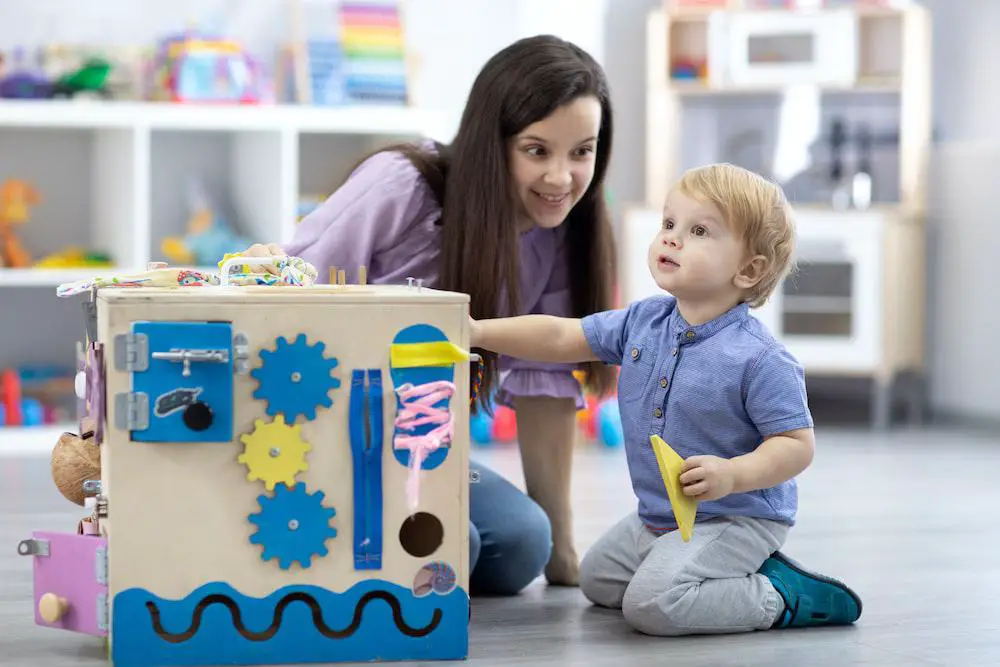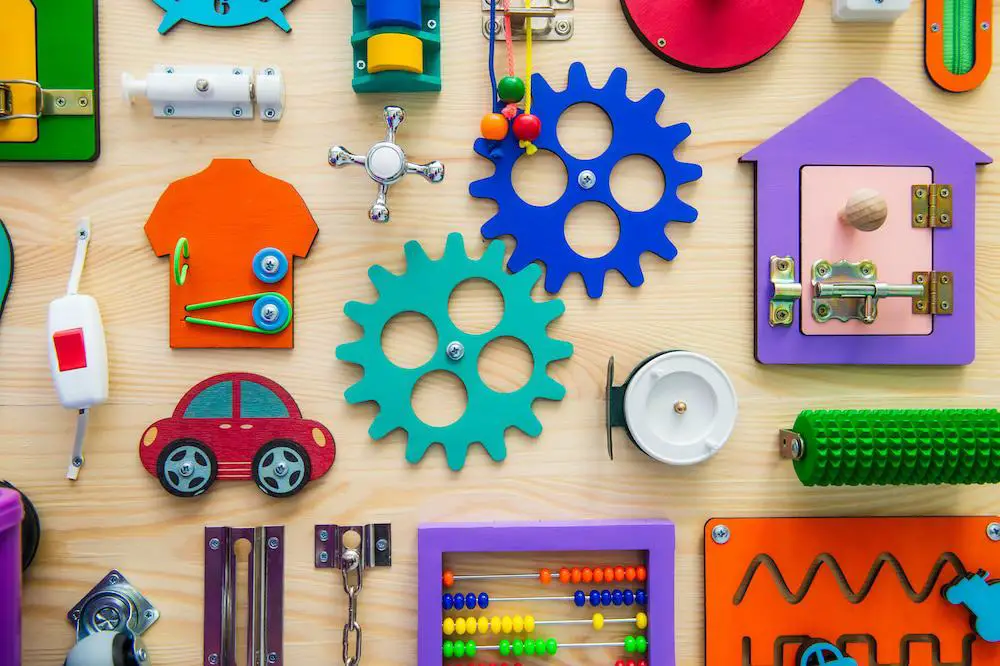Answering what are sensory toys for toddlers can significantly assist with stimulating your child’s senses.
By providing your toddler with an assortment of options, they can get increased value from play.
In this guide, we’ll discuss the best types of sensory toys and how they can help hyper and hypo-sensitive children.
What Are Sensory Issues?
Sensory issues relate directly to how children process stimuli and their reactions to stimuli in their environment.
You might notice your child experiences issues with taste, touch, balance, sight, sound, smell, and body awareness.
With organized sensory toys in their playroom, you can help children develop their senses in a natural environment.
There are two main types of sensory problems that could affect children with autism.
Regardless of what is affecting your children, using sensory toys can help them learn in a natural and comfortable environment.
Also, it gives them the benefit of accessing safe toys that they feel comfortable using. This benefit can help children finally experience the true meaning of playtime.
Differences Between Hyper and Hypo-Sensitive Children
There are two different types of sensory issues that children with autism encounter: hypo- and hyper-sensitivities.
Both will deal with how children process and react to stimuli, but they differ in a couple of ways.
What Is Hypersensitivity?
When a child has hypersensitivity, you’ll find that they have an overt response to stimuli in their environment.
Often, these children will be overly responsive or experience something called sensory overload consistently.
With sensory overload, the most basic sights and sounds can be too overwhelming for them to process.
Sensory overload can also pertain to smells, making children feel overwhelmed by scents that are too overpowering.
Fortunately, there are plenty of proven strategies that can assist with hypersensitivity in children.
It is highly recommended you seek counsel from a licensed occupational therapist to assist with overly responsive children.
What Is Hyposensitivity?
On the other hand, children could be dealing with hyposensitivity, which is when they are under-responsive to stimuli and senses.
You might find that autistic children with hyposensitivity might have higher thresholds for pain or could be unable to control physical coordination.
It’s also quite common for hyposensitive individuals to have issues with balance and necessary motor skills.
You’ll find that most of the toys for hyposensitive children are far more exaggerated than those for hypersensitive.
Parents typically opt for strong-tasting foods, highly textured sensory mats, weighted blankets, and heavily scented items.
Also, children will benefit the most from exuberant types of play, such as running, catching, and dancing.
The Advantages of Sensory Play
Once you know whether your child is dealing with hyper- or hypo-sensitivity, you can easily find the right toys.
There are many fantastic benefits associated with some sensory play that can help your children better understand their environment.
1. Improving Focus
When your child has access to one of their favorite toys that are comfortable for them to use, their focus will be enhanced.
You’ll quickly notice they can relax and focus while playing with that specific toy.
It can be a phenomenal option when they feel overstimulated in a particular environment to help them focus and calm down.
It’s quite often for families to have one to two regular toys that they know can help calm their hypersensitive children.
They are quite essential when bringing them into a new environment or around new people.
2. Enhancing Natural Play
One of the most significant areas for concern with autistic children is their inability to experience natural play.
This issue could be presented either because they are over- or under-stimulated by traditional activities.
By providing them with unique toys designed to promote natural play, they will be able to have fun in all environments.
You’ll also find that over time, the more comfortable they are with play, they’ll be less fearful while playing with others.
3. Developing Motor Skills
Motor skills are an essential developmental milestone for all children, but it’s a specialized focus for autistic individuals.
Sensory toys are specifically developed to help children accentuate their gross and fine motor skills.
Typically, there will be small puzzles and specific pieces of the toy that can be moved around to achieve a goal. For example, them putting a square block through a square hole.
You might also want to consider investing in toys that help them understand the rules of their activity. This will make them more comfortable with trying new toys to find new challenges.
4. Improving Neural Processing Systems
Another enormous advantage of providing your children with new sensory toys is the challenges they’re presented with.
Not only will this help them to develop their motor skills but also improve their neural processing systems.
As children work through new puzzles and activities, neurological pathways will start to be created.
This brain stimulation is essential for assisting children with processing new and different stimuli.
5. Promoting Language Skills
Communication is one of the toughest things to work with regarding many autistic children.
By introducing sensory toys, you are giving them a conduit to help them understand expressions.
They will begin to learn how to better communicate their world and feelings with those around them.
There are plenty of sensory toys that focus primarily on languages, sounds, textures, and tastes to improve communication.

Best Types of Sensory Toys for Children
With the many benefits of sensory toys, it’s no doubt that you’ll want to invest in several for your children.
However, not all toys are made the same, as sensory toys bring a nouveau experience during playtime.
A few examples of the best types of sensory toys include:
1. Sensory Mats
By far, sensory mats are one of the most popular options for autistic children because they are an all-in-one experience.
Kids will be able to experience a variety of colors, textures, and shapes by using their hands and feet to feel around.
You can often find sensory mats that are pre-built with all of the textures you could dream of.
Alternatively, you can opt to buy individual panels and put your sensory mat together, depending on your child’s preference.
Interestingly, there are plenty of activities that you can do with sensory mats, aside from letting your children explore them.
You can have them close their eyes and describe how they feel, and you can add new mats for new experiences.
2. Fidget Spinners
Although they boomed in popularity several years ago for trendy reasons, fidget spinners are incredibly useful.
Aside from being great for individuals with ADD and ADHD, they are highly recommended for children with autism.
Fidget spinners and fidget cubes allows children to keep their hands occupied and stimulated, meanwhile maintaining control.
They will find the spinners’ fast rotation is fun and soothing to manage, as it produces a small vibration.
You’ll also be able to choose from an endless number of colors and designs that are sure to pique their interests.
Above all else, fidget spinners are relatively small, which makes them ideal to bring anywhere.
3. Putty, Slime, and Sand
One of the most affordable toys you can give to your children is putty. You can also make slime at home or buy particular types of sand from toy stores that make less mess.
There are numerous activities that your kids can do with any of the materials. For example, putty is fantastic for molding and texture-based activities.
Slime is great for provoking their senses, as you can make it with different textures, scents, and colors.
Even sand can be a phenomenal substance, as it’s soothing and calming but can also be used for crafting.
We especially love these sensory toys as you can turn it into a family-friendly activity.
There is an endless number of tutorials to make your slime or putty at home with food-safe ingredients.
4. Painting Activities
Instead of relying on traditional paintbrushes and canvas, why not let your kids paint with their hands and feet?
The tactile sensation of rubbing their paint-covered hands onto paper is a fantastic way to become aware of motor skills.
Even though this can be an incredibly fun activity for the whole family, it can also be a learning experience.
You can take the canvas, for example, and draw giant circles, encouraging your child to paint them using their feet.
You’ll love the uniqueness of the art that they create in their minds while providing them with vital developmental exercises at the same time.
How to Choose Sensory Toys for Your Kids
If none of the above sensory toys seem like a good idea for your kids, it’s essential to know what to look for.
Every toy is made differently, and some could be better for specific children. There are a few critical questions to ask yourself before diving head-first into buying toys.
1. What activities do my children enjoy and need help with?
By recognizing your children’s activities, you can easily find toys that fall within their realm of understanding.
However, if you want to give them challenges, you will also need to consider activities they typically avoid or need help doing.
Make a list of improvements and achievements to get an idea of the type of toys to consider.
For example, if your child shows issues with touch, a sensory mat could be a fantastic addition to their playroom.
Alternatively, if they prefer bright lights and loud sounds, handheld games like Simon could be a great option.
Be sure to watch your children as they play to determine if there are specific areas where they could improve.
2. What sensory system needs the most focus?
Remember, there are seven different sensory systems that humans have.
If you want your children to improve one of theirs, you’ll need to know what senses a specific toy works with.
These senses include:
- Proprioception (identifying where the body is in a space)
- Vestibular (how we perceive balance and movement)
- Tactile (touch)
- Vision
- Hearing
- Smell
- Taste
3. Are there any environmental factors to consider?
It’s highly likely your child will have specific environmental concerns to make a note of. They might be more interested in playing at night or might prefer to be outside than inside.
By recognizing their environment and what makes them feel the most comfortable, you can find the perfect toys.
For example, if they are particularly energetic in the morning, you can find quick morning-friendly activities, such as mini-trampolines.
At school, you can consider weighted vests or lap pads to help them feel more comfortable.
Noticing and understanding your child’s behavior in different environments is essential to choosing the right toys.
What Are Sensory Toys for Toddlers? Final Thoughts
What are sensory toys for toddlers? There are plenty of answers. From hyposensitive-friendly toys to those for hypersensitive children, the list is extensive.
Knowing what makes your children comfortable and which areas need improvement can help you choose the best ones.

